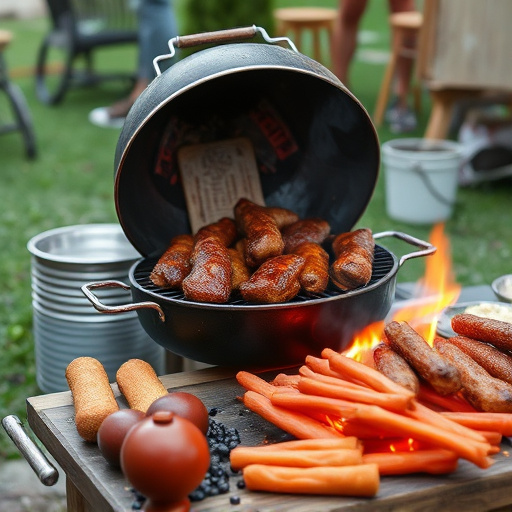Selecting the right cut of ribs (baby back or spare rib) and using a dry rub are key for crafting tender, flavorful BBQ pork ribs. Cook low and slow (225°F – 275°F) for several hours to break down collagen. Apply BBQ sauce early and late for moisture and flavor. Store leftovers in an airtight container up to 3-4 days; reheat at 350°F (175°C). Enjoy with sides like coleslaw or mashed potatoes, paired with beer or whiskey.
“Unleash the mouthwatering aroma of perfectly cooked BBQ pork ribs with our comprehensive guide to achieving the ultimate slow-cooked delight. From selecting the ideal cut for that tender, fall-off-the-bone texture to mastering the art of dry rubs and precise smoking techniques, we’ve got you covered. Learn the secrets behind the perfect BBQ sauce timing and discover the science behind cooking time and temperature. Get ready to impress with this step-by-step journey to crafting a classic BBQ pork rib recipe.”
- Selecting the Perfect Cut for Slow-Cooked Ribs
- The Magic of Dry Rub: Seasoning Your Ribs
- Smoking 101: Techniques for Low and Slow Cooking
- Master the Art of BBQ Sauce: When to Apply
- Cooking Time and Temperature: A Comprehensive Guide
- Tips for Achieving Tender, Fall-Off-the-Bone Ribs
- Servings and Pairing Suggestions
- Storing and Reheating Leftovers
Selecting the Perfect Cut for Slow-Cooked Ribs
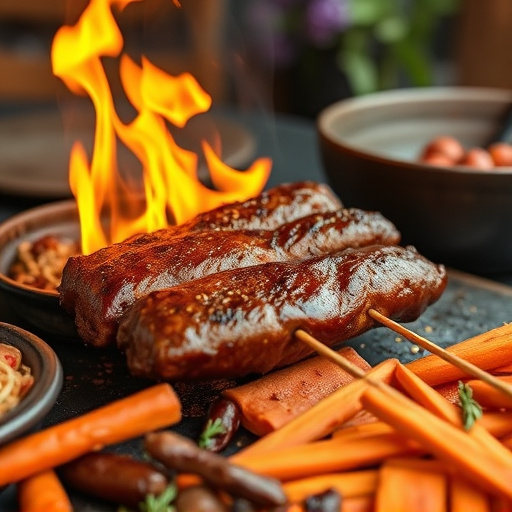
When it comes to slow-cooked ribs, selecting the right cut is key to achieving that perfect, tender, and flavorful result. Opt for baby back or spare rib meat as these cuts have less fat and more meat, ensuring a healthier yet delicious BBQ pork rib recipe. The meaty portion between the spine and the bone, known as the “meaty bone,” is particularly desirable as it becomes incredibly tender when cooked low and slow. Avoid rib tips or larger cuts like short ribs unless you plan to cook them for an extended period, as these may require a higher temperature to reach the same level of tenderness.
For best results in your BBQ pork rib recipe, look for ribs that have a good marbling of fat, which will help keep the meat moist during the slow-cooking process. Check that the bones are intact and meaty, without excessive crackling or hard cartilage. Fresh, high-quality ribs will make all the difference in the final dish, ensuring a mouthwatering, succulent meal that’s perfect for sharing with family and friends.
The Magic of Dry Rub: Seasoning Your Ribs

The art of BBQ pork ribs starts with a simple yet powerful ingredient: dry rub. This magical blend of spices is what transforms ordinary ribs into a mouthwatering delicacy. A well-crafted dry rub consists of a carefully curated combination of salt, pepper, garlic, paprika, and other aromatic herbs. These seasonings not only enhance the natural flavors of the pork but also act as a barrier, helping to keep the meat tender and juicy during the long, slow cooking process.
When preparing your BBQ pork rib recipe, take your time to make or procure a high-quality dry rub. The rubbing of this spice mixture all over the ribs before cooking is a crucial step that sets the stage for a truly exceptional dining experience. As the ribs cook low and slow, the spices penetrate the meat, creating a complex and savory taste profile that will leave you craving more.
Smoking 101: Techniques for Low and Slow Cooking
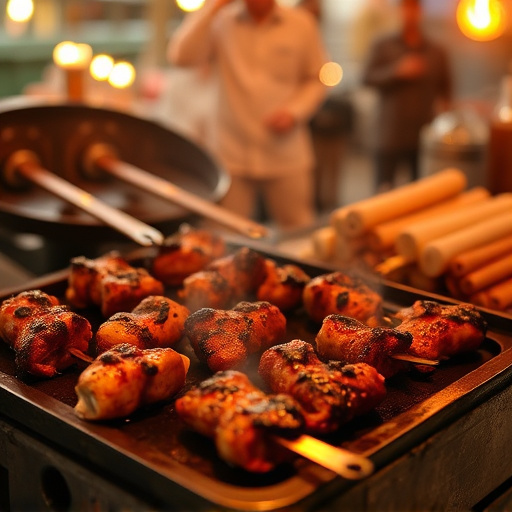
Smoking 101: Techniques for Low and Slow Cooking
Low and slow cooking is an art form in the world of BBQ, especially when it comes to crafting the perfect BBQ pork rib recipe. This method involves slowly cooking meat at low temperatures—typically between 225°F to 250°F (107°C to 121°C)—for an extended period, often several hours or even days. The key is to infuse the meat with flavor through smoke and moisture while breaking down connective tissues, resulting in tender, juicy ribs.
To achieve this, many pitmasters rely on a variety of smoking techniques. Indirect heat, where hot coals or wood chips are placed away from the meat, allows for steady, low-temperature cooking. The use of different types of wood chips—such as hickory, oak, or mesquite—can impart unique smoky flavors, adding depth to your BBQ pork rib recipe. Regular basting with a dry rub or sauce not only keeps the ribs moist but also helps in developing that characteristic caramelized crust.
Master the Art of BBQ Sauce: When to Apply
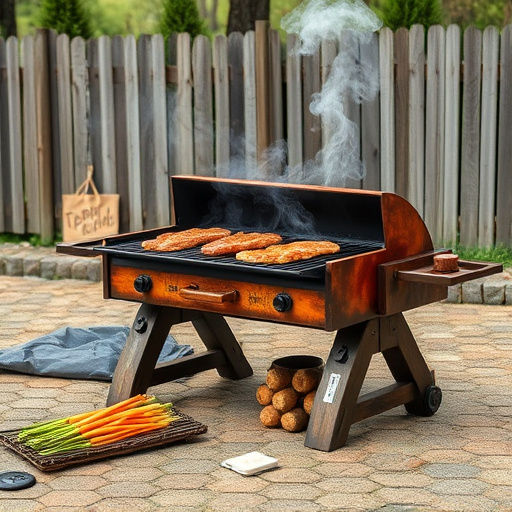
Mastering the art of BBQ sauce application is a crucial step in achieving mouthwatering, tender BBQ pork ribs in your low-and-slow cooking process. The timing and technique can significantly impact the final flavor profile. Apply the sauce early on during the slow-cooking process to allow it to penetrate the meat, infusing moisture and flavor. This initial coating not only adds sweetness but also helps tenderize the ribs.
As the ribs cook, reserve a small amount of your BBQ sauce for a late-stage application just before serving. This strategy ensures that the sauce’s glaze stays shiny and provides an extra burst of flavor without becoming overly saucy or drying out the ribs. It’s a delicate balance, but when executed right, it can elevate your BBQ pork rib recipe to the next level, leaving your taste buds craving more.
Cooking Time and Temperature: A Comprehensive Guide
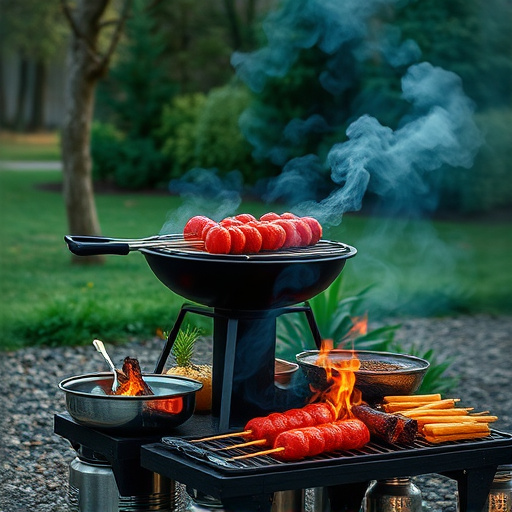
When it comes to crafting the perfect BBQ pork rib recipe, time and temperature are everything. The low-and-slow method is a classic for a reason: it allows the meat to tenderize and the flavors to deeply infuse. Typically, cooking ribs at a steady 225°F (107°C) for around 3 to 4 hours per pound will yield incredibly juicy, fall-off-the-bone results. This gentle approach ensures that the collagen in the meat breaks down, transforming into gelatin and adding to the ribs’ tenderness.
For best results, use a reliable smoker or a slow cooker designed for this purpose. The low temperature may seem slow, but it’s essential for achieving the desired texture. After the initial cooking period, you can increase the temperature slightly (around 300°F or 150°C) to accelerate the process without compromising the ribs’ quality. Always rely on the internal meat thermometer to confirm doneness; when the meat reaches an internal temperature of 203°F (95°C), it’s time to pull those mouthwatering ribs from the heat and let them rest before slicing and serving your delectable BBQ pork rib recipe.
Tips for Achieving Tender, Fall-Off-the-Bone Ribs
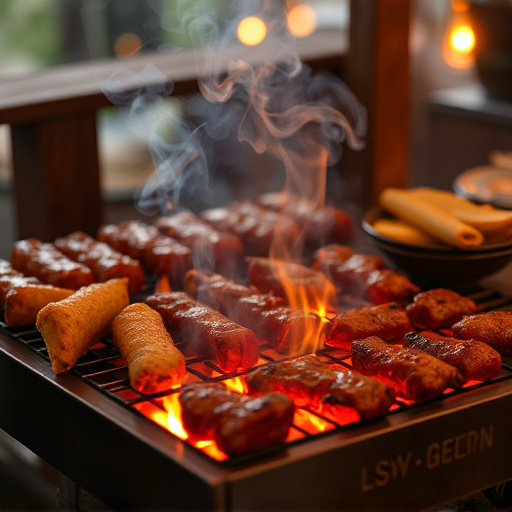
Achieving tender, fall-off-the-bone ribs is an art that every BBQ enthusiast should master. The key lies in patience and understanding the power of low and slow cooking. When preparing a BBQ Pork Rib Recipe, start by selecting the right cut of ribs—baby backs or St. Louis cuts are popular choices for their meaty texture and less bone structure.
Next, dry-rubbing is essential; a good spice blend will penetrate the meat, enhancing its natural flavors. Allow the rub to sit for at least 30 minutes before cooking, giving the spices time to work their magic. Cooking at a low temperature, typically between 225°F and 275°F (107°C to 135°C), for several hours ensures the collagen in the ribs breaks down, resulting in tender meat. Regularly basting with your favorite BBQ sauce adds moisture and flavor as the ribs cook slowly, bringing them closer to that coveted fall-off-the-bone texture.
Servings and Pairing Suggestions
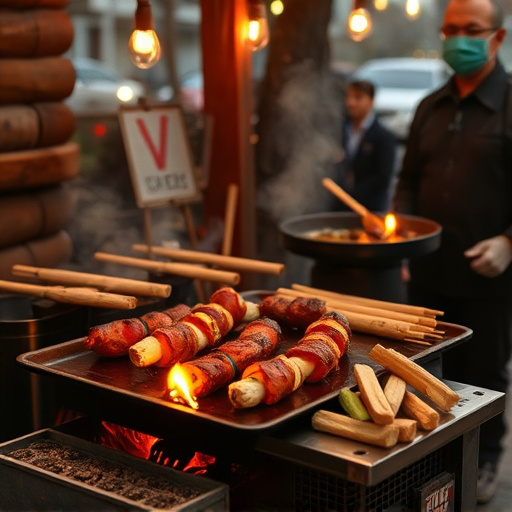
When it comes to serving size, a classic BBQ pork rib recipe yields about 4-6 servings, perfect for sharing and family dinners. For a truly satisfying meal, pair your ribs with a side of crispy coleslaw or creamy mashed potatoes—the contrast in textures will delight your taste buds. Completing the experience, a cold beer or a rich, smooth whiskey pairs wonderfully with these slow-cooked delicacies, offering a harmonious blend of flavors that elevate the classic BBQ pork rib recipe to new heights.
Storing and Reheating Leftovers
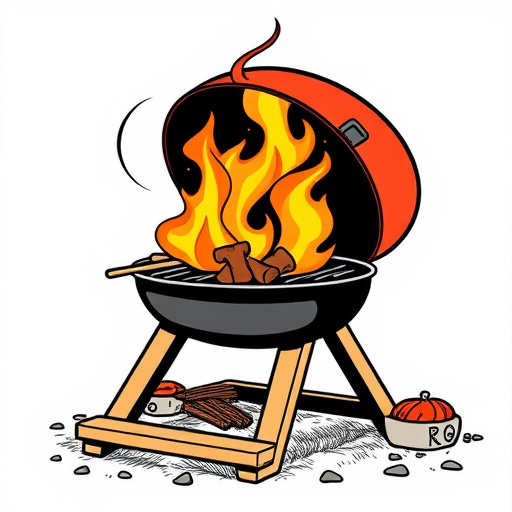
When it comes to storing and reheating leftovers of your delicious BBQ pork rib recipe, there are a few simple steps to maintain that mouthwatering flavor and texture. First, let the ribs cool down to room temperature before placing them in an airtight container. This helps prevent any bacterial growth and keeps them fresh for up to 3-4 days in the refrigerator.
To reheat, warm your oven to around 350°F (175°C). Place the ribs in a baking dish and cover them loosely with foil. Reheat for about 20-25 minutes, or until they reach your desired temperature. Remove the foil to crisp up the exterior if needed, but be careful not to overcook. This method ensures that your BBQ pork rib recipe remains as tantalizing as the day you cooked it.
